International Civil Aviation: Collaboration and Standardization Concepts
VerifiedAdded on 2022/11/15
|17
|4093
|400
AI Summary
This paper highlights the concepts adopted by ICAO to enhance collaboration with a focus on air transport operators towards safety enhancement. It covers the obligations of contracting states, roles of supra-national regulators, and more.
Contribute Materials
Your contribution can guide someone’s learning journey. Share your
documents today.
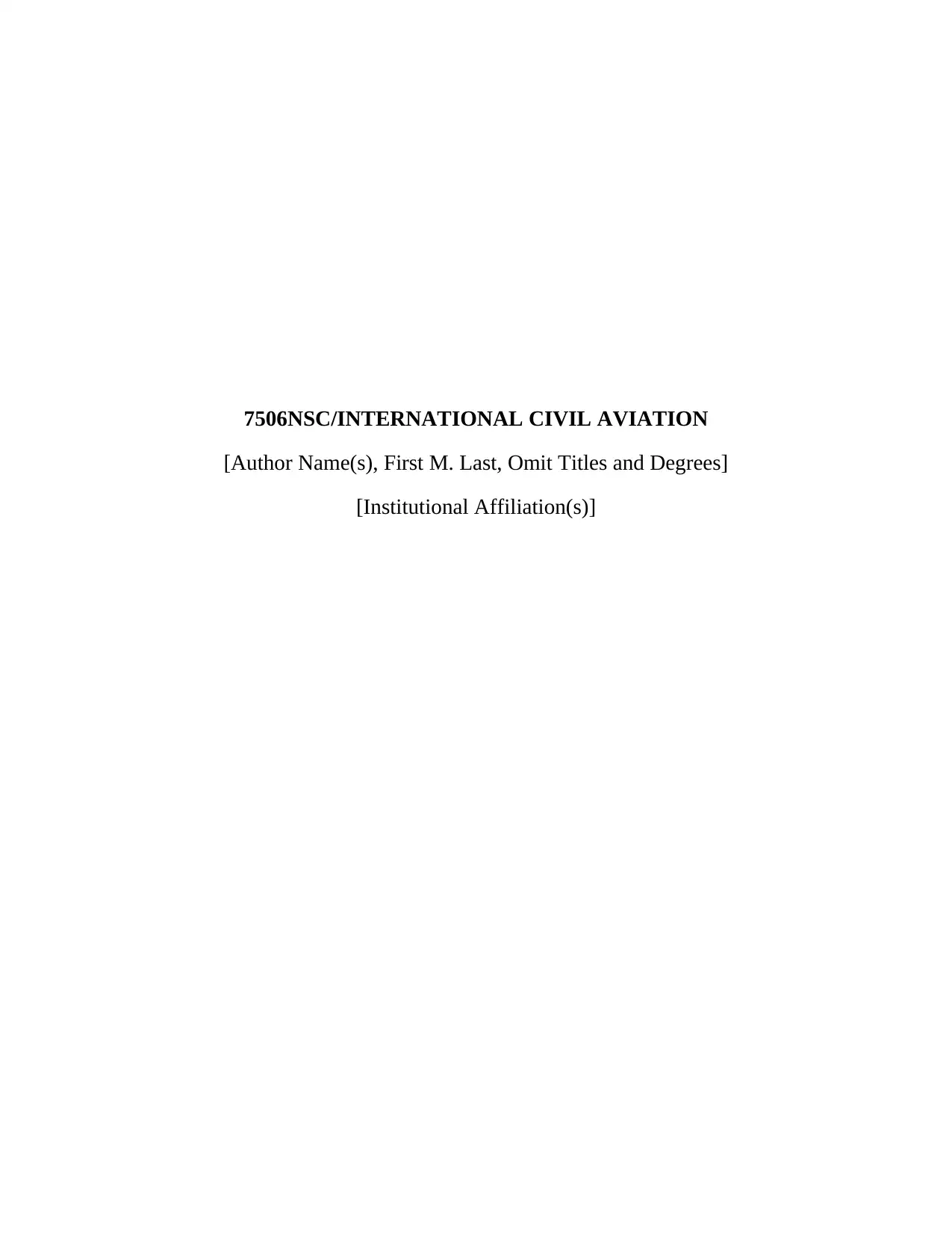
7506NSC/INTERNATIONAL CIVIL AVIATION
[Author Name(s), First M. Last, Omit Titles and Degrees]
[Institutional Affiliation(s)]
[Author Name(s), First M. Last, Omit Titles and Degrees]
[Institutional Affiliation(s)]
Secure Best Marks with AI Grader
Need help grading? Try our AI Grader for instant feedback on your assignments.
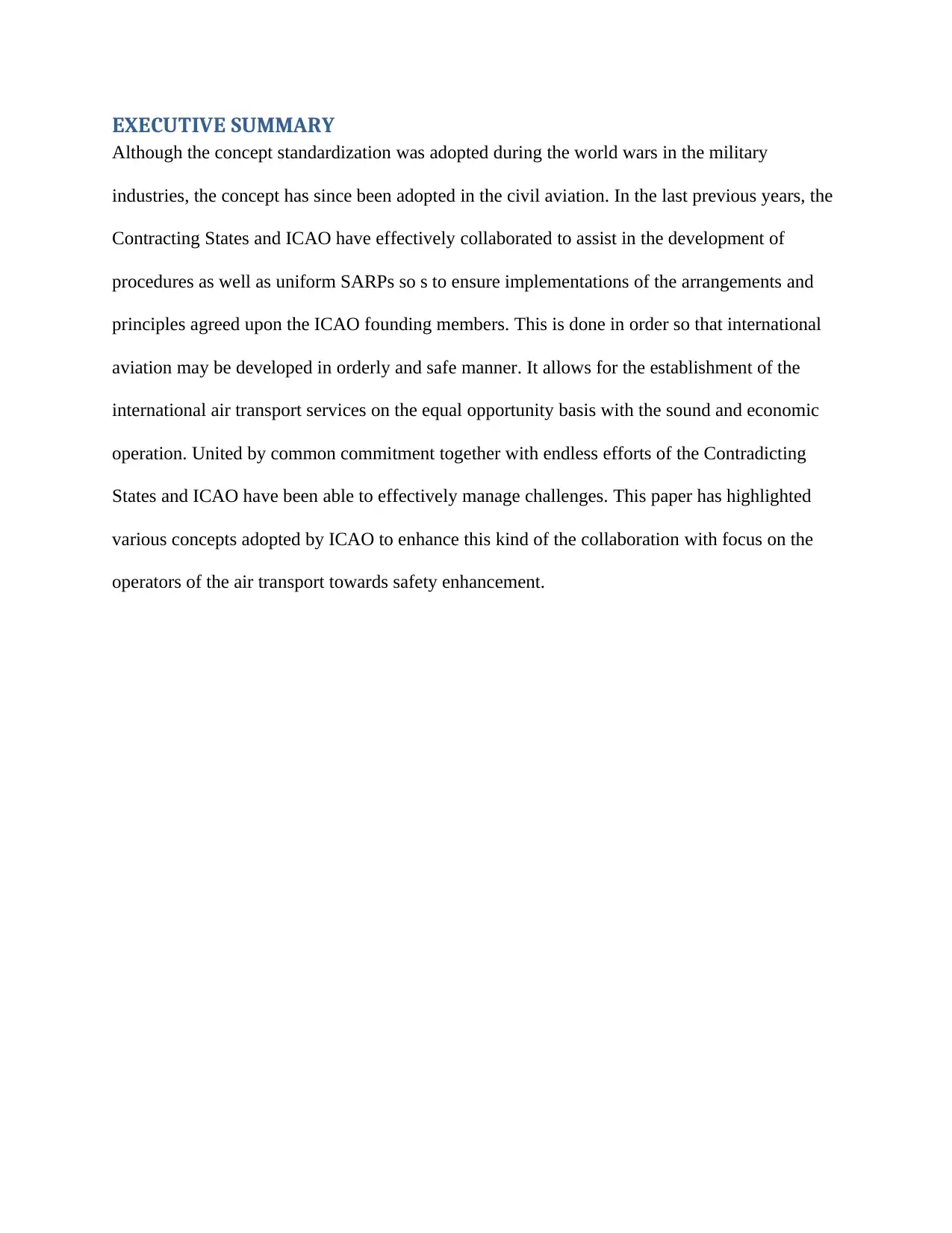
EXECUTIVE SUMMARY
Although the concept standardization was adopted during the world wars in the military
industries, the concept has since been adopted in the civil aviation. In the last previous years, the
Contracting States and ICAO have effectively collaborated to assist in the development of
procedures as well as uniform SARPs so s to ensure implementations of the arrangements and
principles agreed upon the ICAO founding members. This is done in order so that international
aviation may be developed in orderly and safe manner. It allows for the establishment of the
international air transport services on the equal opportunity basis with the sound and economic
operation. United by common commitment together with endless efforts of the Contradicting
States and ICAO have been able to effectively manage challenges. This paper has highlighted
various concepts adopted by ICAO to enhance this kind of the collaboration with focus on the
operators of the air transport towards safety enhancement.
Although the concept standardization was adopted during the world wars in the military
industries, the concept has since been adopted in the civil aviation. In the last previous years, the
Contracting States and ICAO have effectively collaborated to assist in the development of
procedures as well as uniform SARPs so s to ensure implementations of the arrangements and
principles agreed upon the ICAO founding members. This is done in order so that international
aviation may be developed in orderly and safe manner. It allows for the establishment of the
international air transport services on the equal opportunity basis with the sound and economic
operation. United by common commitment together with endless efforts of the Contradicting
States and ICAO have been able to effectively manage challenges. This paper has highlighted
various concepts adopted by ICAO to enhance this kind of the collaboration with focus on the
operators of the air transport towards safety enhancement.
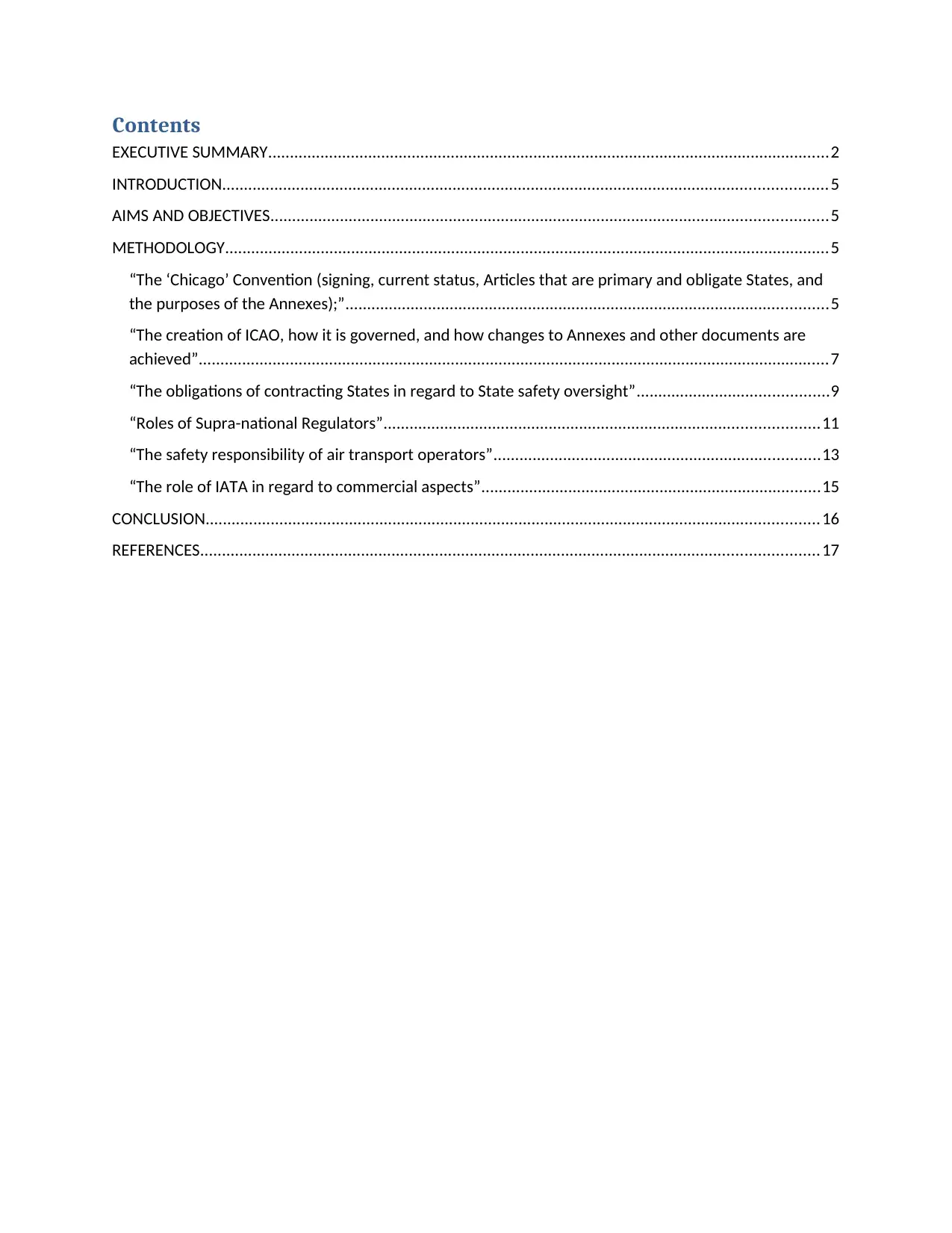
Contents
EXECUTIVE SUMMARY.................................................................................................................................2
INTRODUCTION...........................................................................................................................................5
AIMS AND OBJECTIVES................................................................................................................................5
METHODOLOGY...........................................................................................................................................5
“The ‘Chicago’ Convention (signing, current status, Articles that are primary and obligate States, and
the purposes of the Annexes);”...............................................................................................................5
“The creation of ICAO, how it is governed, and how changes to Annexes and other documents are
achieved”.................................................................................................................................................7
“The obligations of contracting States in regard to State safety oversight”............................................9
“Roles of Supra-national Regulators”....................................................................................................11
“The safety responsibility of air transport operators”...........................................................................13
“The role of IATA in regard to commercial aspects”..............................................................................15
CONCLUSION.............................................................................................................................................16
REFERENCES..............................................................................................................................................17
EXECUTIVE SUMMARY.................................................................................................................................2
INTRODUCTION...........................................................................................................................................5
AIMS AND OBJECTIVES................................................................................................................................5
METHODOLOGY...........................................................................................................................................5
“The ‘Chicago’ Convention (signing, current status, Articles that are primary and obligate States, and
the purposes of the Annexes);”...............................................................................................................5
“The creation of ICAO, how it is governed, and how changes to Annexes and other documents are
achieved”.................................................................................................................................................7
“The obligations of contracting States in regard to State safety oversight”............................................9
“Roles of Supra-national Regulators”....................................................................................................11
“The safety responsibility of air transport operators”...........................................................................13
“The role of IATA in regard to commercial aspects”..............................................................................15
CONCLUSION.............................................................................................................................................16
REFERENCES..............................................................................................................................................17
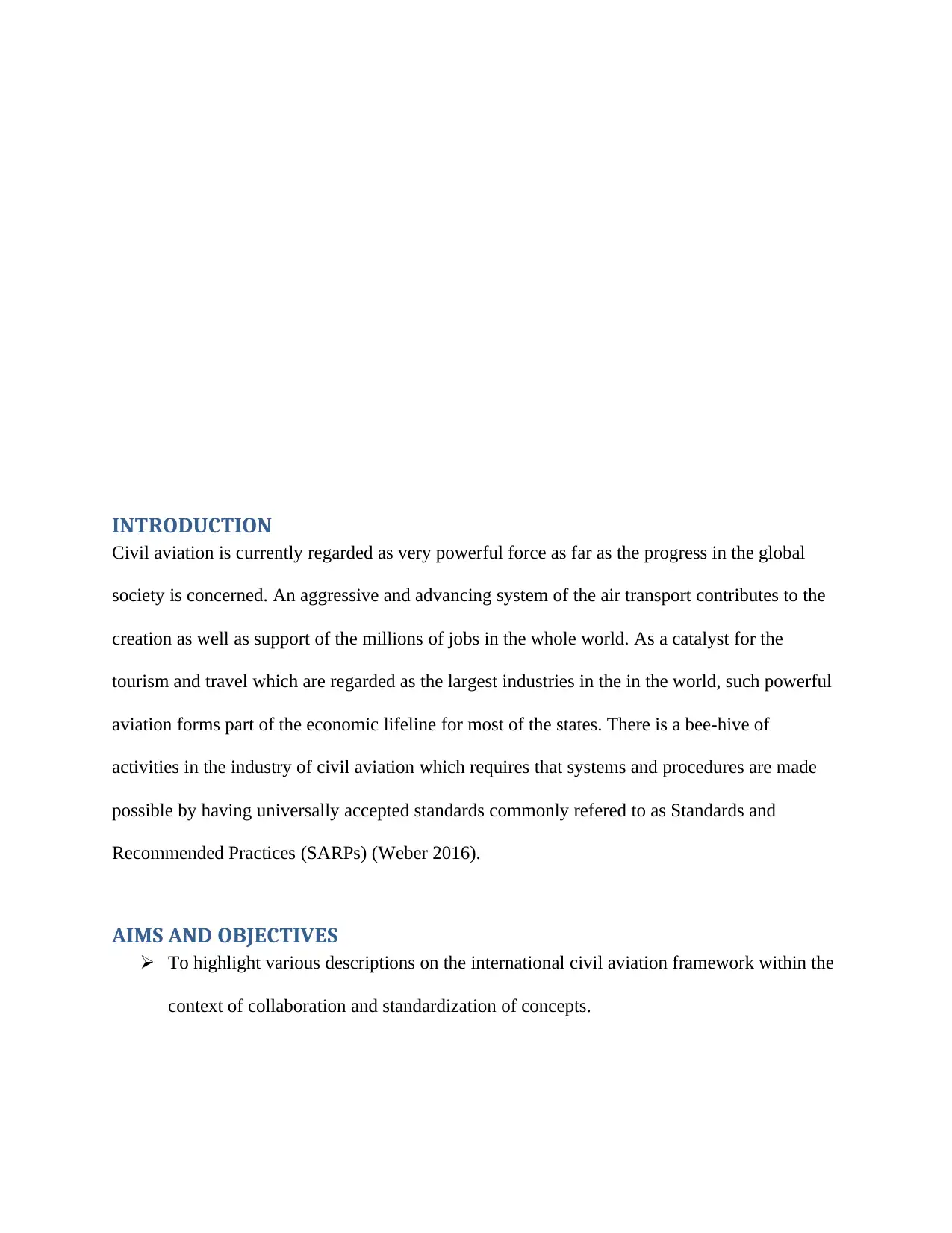
INTRODUCTION
Civil aviation is currently regarded as very powerful force as far as the progress in the global
society is concerned. An aggressive and advancing system of the air transport contributes to the
creation as well as support of the millions of jobs in the whole world. As a catalyst for the
tourism and travel which are regarded as the largest industries in the in the world, such powerful
aviation forms part of the economic lifeline for most of the states. There is a bee-hive of
activities in the industry of civil aviation which requires that systems and procedures are made
possible by having universally accepted standards commonly refered to as Standards and
Recommended Practices (SARPs) (Weber 2016).
AIMS AND OBJECTIVES
To highlight various descriptions on the international civil aviation framework within the
context of collaboration and standardization of concepts.
Civil aviation is currently regarded as very powerful force as far as the progress in the global
society is concerned. An aggressive and advancing system of the air transport contributes to the
creation as well as support of the millions of jobs in the whole world. As a catalyst for the
tourism and travel which are regarded as the largest industries in the in the world, such powerful
aviation forms part of the economic lifeline for most of the states. There is a bee-hive of
activities in the industry of civil aviation which requires that systems and procedures are made
possible by having universally accepted standards commonly refered to as Standards and
Recommended Practices (SARPs) (Weber 2016).
AIMS AND OBJECTIVES
To highlight various descriptions on the international civil aviation framework within the
context of collaboration and standardization of concepts.
Secure Best Marks with AI Grader
Need help grading? Try our AI Grader for instant feedback on your assignments.
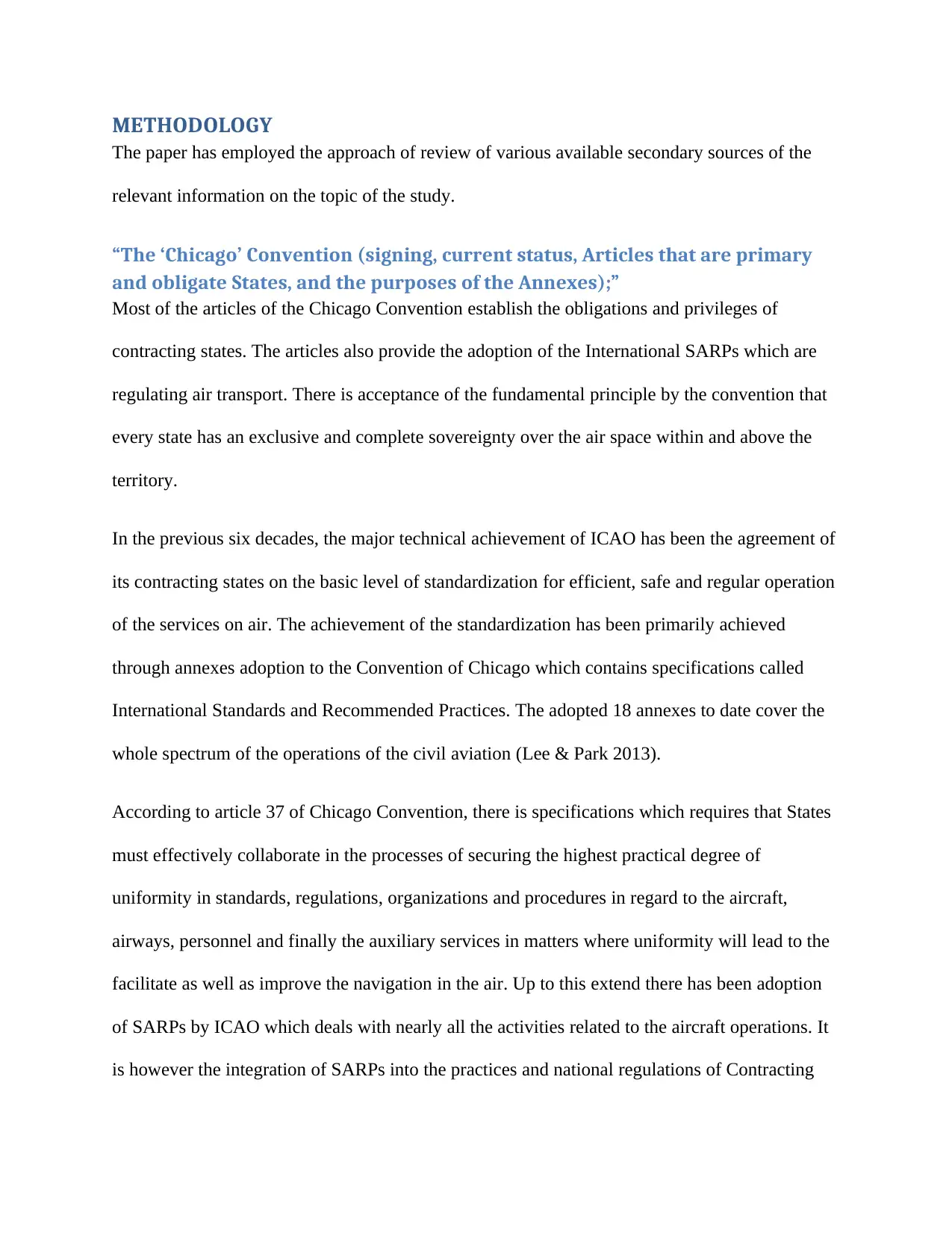
METHODOLOGY
The paper has employed the approach of review of various available secondary sources of the
relevant information on the topic of the study.
“The ‘Chicago’ Convention (signing, current status, Articles that are primary
and obligate States, and the purposes of the Annexes);”
Most of the articles of the Chicago Convention establish the obligations and privileges of
contracting states. The articles also provide the adoption of the International SARPs which are
regulating air transport. There is acceptance of the fundamental principle by the convention that
every state has an exclusive and complete sovereignty over the air space within and above the
territory.
In the previous six decades, the major technical achievement of ICAO has been the agreement of
its contracting states on the basic level of standardization for efficient, safe and regular operation
of the services on air. The achievement of the standardization has been primarily achieved
through annexes adoption to the Convention of Chicago which contains specifications called
International Standards and Recommended Practices. The adopted 18 annexes to date cover the
whole spectrum of the operations of the civil aviation (Lee & Park 2013).
According to article 37 of Chicago Convention, there is specifications which requires that States
must effectively collaborate in the processes of securing the highest practical degree of
uniformity in standards, regulations, organizations and procedures in regard to the aircraft,
airways, personnel and finally the auxiliary services in matters where uniformity will lead to the
facilitate as well as improve the navigation in the air. Up to this extend there has been adoption
of SARPs by ICAO which deals with nearly all the activities related to the aircraft operations. It
is however the integration of SARPs into the practices and national regulations of Contracting
The paper has employed the approach of review of various available secondary sources of the
relevant information on the topic of the study.
“The ‘Chicago’ Convention (signing, current status, Articles that are primary
and obligate States, and the purposes of the Annexes);”
Most of the articles of the Chicago Convention establish the obligations and privileges of
contracting states. The articles also provide the adoption of the International SARPs which are
regulating air transport. There is acceptance of the fundamental principle by the convention that
every state has an exclusive and complete sovereignty over the air space within and above the
territory.
In the previous six decades, the major technical achievement of ICAO has been the agreement of
its contracting states on the basic level of standardization for efficient, safe and regular operation
of the services on air. The achievement of the standardization has been primarily achieved
through annexes adoption to the Convention of Chicago which contains specifications called
International Standards and Recommended Practices. The adopted 18 annexes to date cover the
whole spectrum of the operations of the civil aviation (Lee & Park 2013).
According to article 37 of Chicago Convention, there is specifications which requires that States
must effectively collaborate in the processes of securing the highest practical degree of
uniformity in standards, regulations, organizations and procedures in regard to the aircraft,
airways, personnel and finally the auxiliary services in matters where uniformity will lead to the
facilitate as well as improve the navigation in the air. Up to this extend there has been adoption
of SARPs by ICAO which deals with nearly all the activities related to the aircraft operations. It
is however the integration of SARPs into the practices and national regulations of Contracting
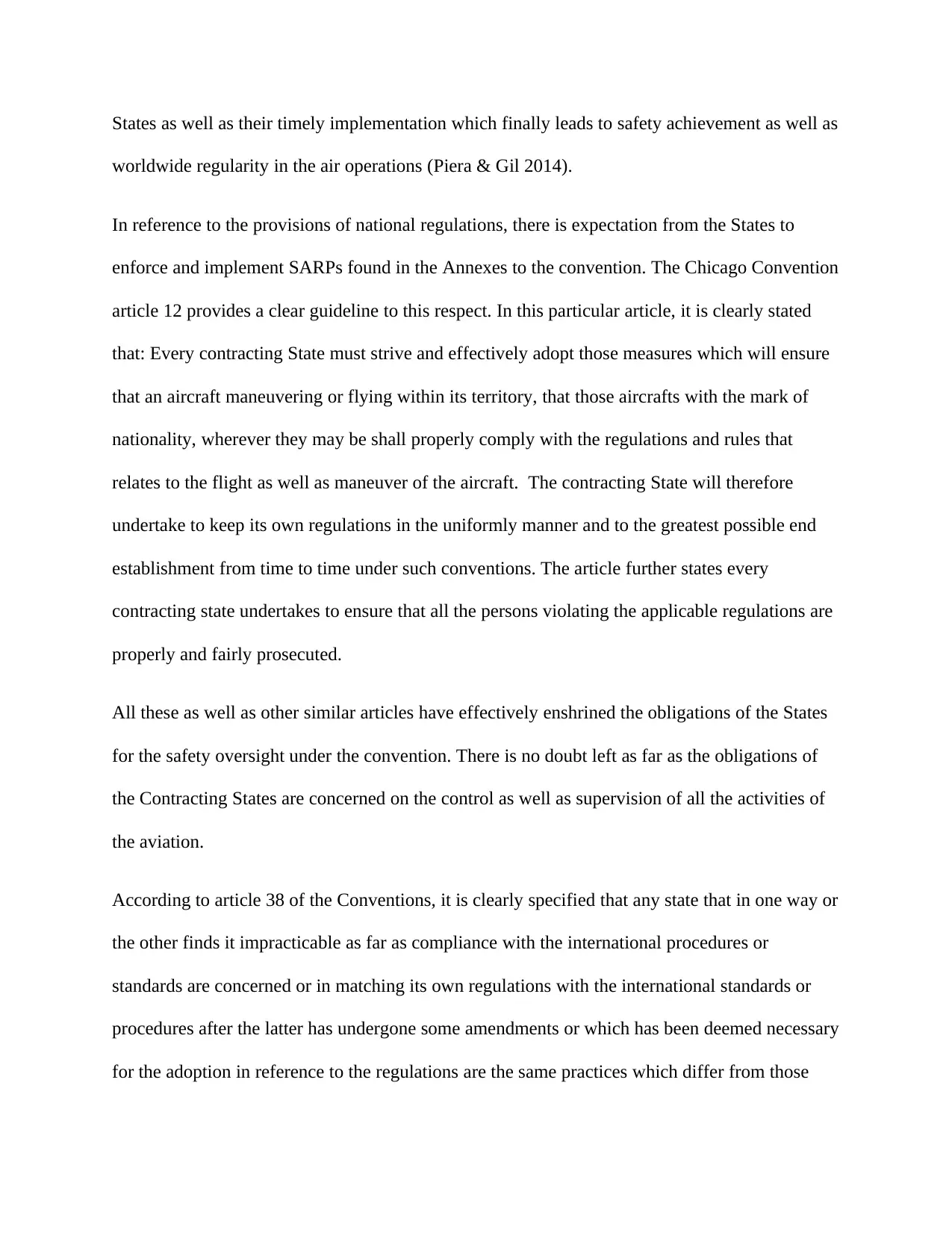
States as well as their timely implementation which finally leads to safety achievement as well as
worldwide regularity in the air operations (Piera & Gil 2014).
In reference to the provisions of national regulations, there is expectation from the States to
enforce and implement SARPs found in the Annexes to the convention. The Chicago Convention
article 12 provides a clear guideline to this respect. In this particular article, it is clearly stated
that: Every contracting State must strive and effectively adopt those measures which will ensure
that an aircraft maneuvering or flying within its territory, that those aircrafts with the mark of
nationality, wherever they may be shall properly comply with the regulations and rules that
relates to the flight as well as maneuver of the aircraft. The contracting State will therefore
undertake to keep its own regulations in the uniformly manner and to the greatest possible end
establishment from time to time under such conventions. The article further states every
contracting state undertakes to ensure that all the persons violating the applicable regulations are
properly and fairly prosecuted.
All these as well as other similar articles have effectively enshrined the obligations of the States
for the safety oversight under the convention. There is no doubt left as far as the obligations of
the Contracting States are concerned on the control as well as supervision of all the activities of
the aviation.
According to article 38 of the Conventions, it is clearly specified that any state that in one way or
the other finds it impracticable as far as compliance with the international procedures or
standards are concerned or in matching its own regulations with the international standards or
procedures after the latter has undergone some amendments or which has been deemed necessary
for the adoption in reference to the regulations are the same practices which differ from those
worldwide regularity in the air operations (Piera & Gil 2014).
In reference to the provisions of national regulations, there is expectation from the States to
enforce and implement SARPs found in the Annexes to the convention. The Chicago Convention
article 12 provides a clear guideline to this respect. In this particular article, it is clearly stated
that: Every contracting State must strive and effectively adopt those measures which will ensure
that an aircraft maneuvering or flying within its territory, that those aircrafts with the mark of
nationality, wherever they may be shall properly comply with the regulations and rules that
relates to the flight as well as maneuver of the aircraft. The contracting State will therefore
undertake to keep its own regulations in the uniformly manner and to the greatest possible end
establishment from time to time under such conventions. The article further states every
contracting state undertakes to ensure that all the persons violating the applicable regulations are
properly and fairly prosecuted.
All these as well as other similar articles have effectively enshrined the obligations of the States
for the safety oversight under the convention. There is no doubt left as far as the obligations of
the Contracting States are concerned on the control as well as supervision of all the activities of
the aviation.
According to article 38 of the Conventions, it is clearly specified that any state that in one way or
the other finds it impracticable as far as compliance with the international procedures or
standards are concerned or in matching its own regulations with the international standards or
procedures after the latter has undergone some amendments or which has been deemed necessary
for the adoption in reference to the regulations are the same practices which differ from those
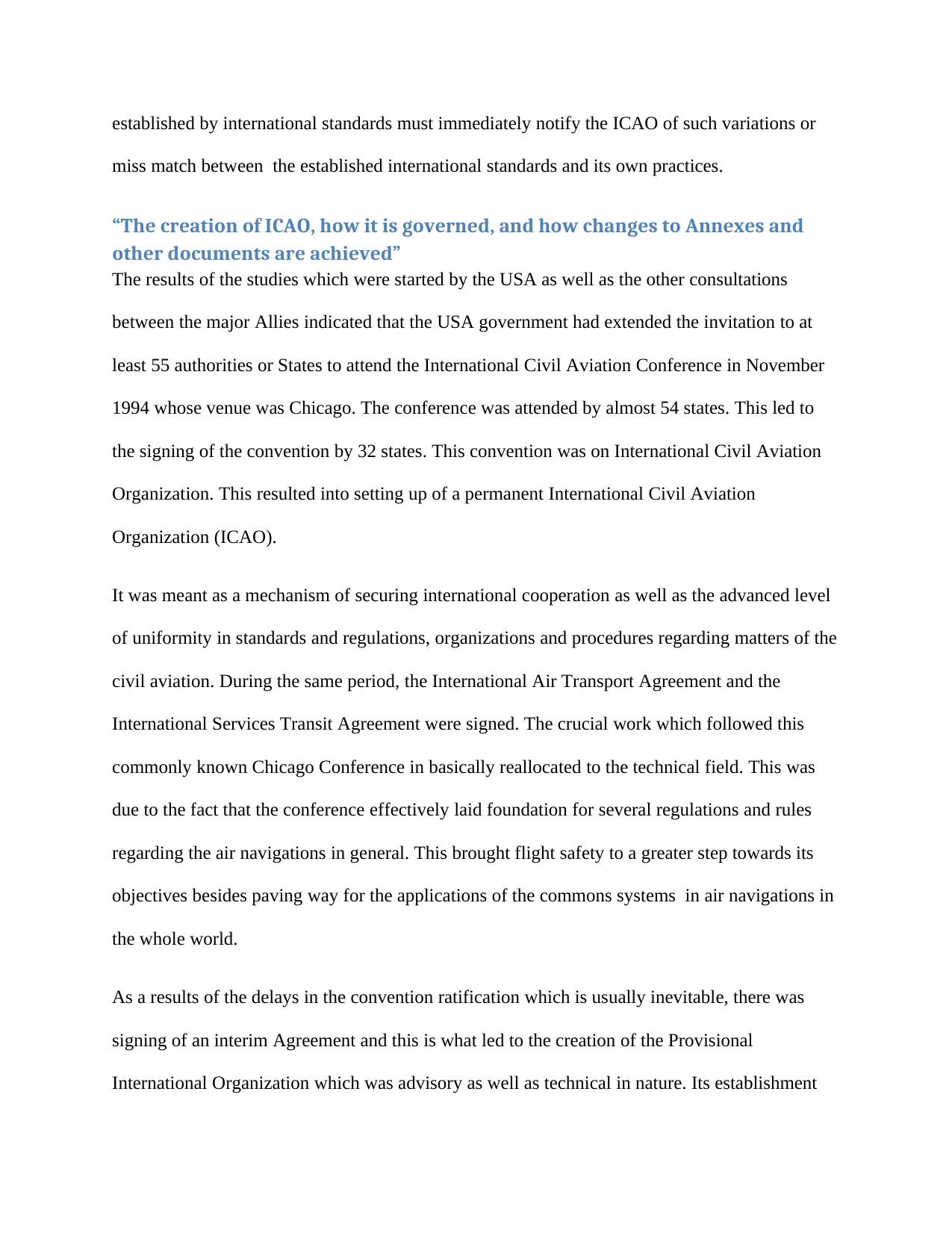
established by international standards must immediately notify the ICAO of such variations or
miss match between the established international standards and its own practices.
“The creation of ICAO, how it is governed, and how changes to Annexes and
other documents are achieved”
The results of the studies which were started by the USA as well as the other consultations
between the major Allies indicated that the USA government had extended the invitation to at
least 55 authorities or States to attend the International Civil Aviation Conference in November
1994 whose venue was Chicago. The conference was attended by almost 54 states. This led to
the signing of the convention by 32 states. This convention was on International Civil Aviation
Organization. This resulted into setting up of a permanent International Civil Aviation
Organization (ICAO).
It was meant as a mechanism of securing international cooperation as well as the advanced level
of uniformity in standards and regulations, organizations and procedures regarding matters of the
civil aviation. During the same period, the International Air Transport Agreement and the
International Services Transit Agreement were signed. The crucial work which followed this
commonly known Chicago Conference in basically reallocated to the technical field. This was
due to the fact that the conference effectively laid foundation for several regulations and rules
regarding the air navigations in general. This brought flight safety to a greater step towards its
objectives besides paving way for the applications of the commons systems in air navigations in
the whole world.
As a results of the delays in the convention ratification which is usually inevitable, there was
signing of an interim Agreement and this is what led to the creation of the Provisional
International Organization which was advisory as well as technical in nature. Its establishment
miss match between the established international standards and its own practices.
“The creation of ICAO, how it is governed, and how changes to Annexes and
other documents are achieved”
The results of the studies which were started by the USA as well as the other consultations
between the major Allies indicated that the USA government had extended the invitation to at
least 55 authorities or States to attend the International Civil Aviation Conference in November
1994 whose venue was Chicago. The conference was attended by almost 54 states. This led to
the signing of the convention by 32 states. This convention was on International Civil Aviation
Organization. This resulted into setting up of a permanent International Civil Aviation
Organization (ICAO).
It was meant as a mechanism of securing international cooperation as well as the advanced level
of uniformity in standards and regulations, organizations and procedures regarding matters of the
civil aviation. During the same period, the International Air Transport Agreement and the
International Services Transit Agreement were signed. The crucial work which followed this
commonly known Chicago Conference in basically reallocated to the technical field. This was
due to the fact that the conference effectively laid foundation for several regulations and rules
regarding the air navigations in general. This brought flight safety to a greater step towards its
objectives besides paving way for the applications of the commons systems in air navigations in
the whole world.
As a results of the delays in the convention ratification which is usually inevitable, there was
signing of an interim Agreement and this is what led to the creation of the Provisional
International Organization which was advisory as well as technical in nature. Its establishment
Paraphrase This Document
Need a fresh take? Get an instant paraphrase of this document with our AI Paraphraser
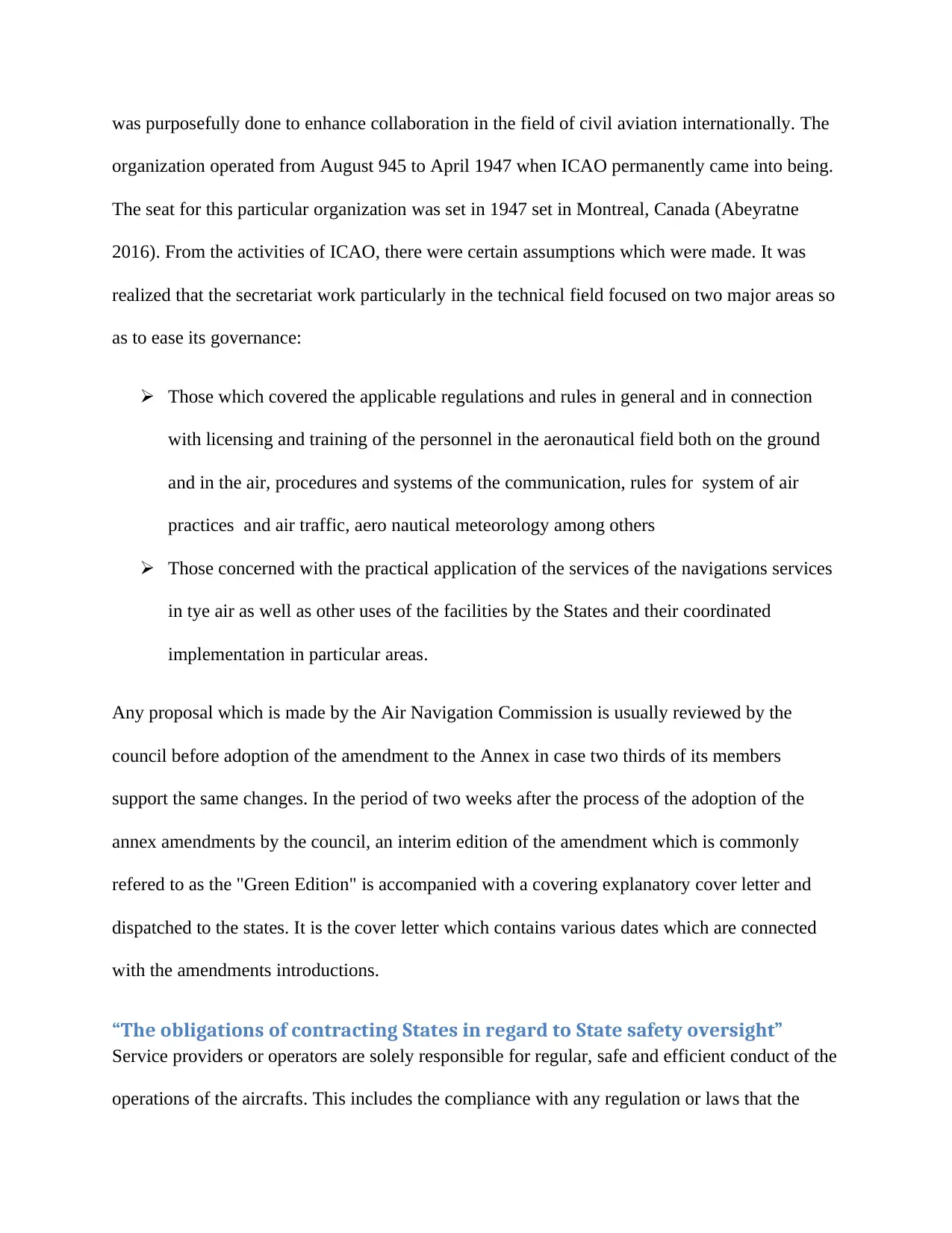
was purposefully done to enhance collaboration in the field of civil aviation internationally. The
organization operated from August 945 to April 1947 when ICAO permanently came into being.
The seat for this particular organization was set in 1947 set in Montreal, Canada (Abeyratne
2016). From the activities of ICAO, there were certain assumptions which were made. It was
realized that the secretariat work particularly in the technical field focused on two major areas so
as to ease its governance:
Those which covered the applicable regulations and rules in general and in connection
with licensing and training of the personnel in the aeronautical field both on the ground
and in the air, procedures and systems of the communication, rules for system of air
practices and air traffic, aero nautical meteorology among others
Those concerned with the practical application of the services of the navigations services
in tye air as well as other uses of the facilities by the States and their coordinated
implementation in particular areas.
Any proposal which is made by the Air Navigation Commission is usually reviewed by the
council before adoption of the amendment to the Annex in case two thirds of its members
support the same changes. In the period of two weeks after the process of the adoption of the
annex amendments by the council, an interim edition of the amendment which is commonly
refered to as the "Green Edition" is accompanied with a covering explanatory cover letter and
dispatched to the states. It is the cover letter which contains various dates which are connected
with the amendments introductions.
“The obligations of contracting States in regard to State safety oversight”
Service providers or operators are solely responsible for regular, safe and efficient conduct of the
operations of the aircrafts. This includes the compliance with any regulation or laws that the
organization operated from August 945 to April 1947 when ICAO permanently came into being.
The seat for this particular organization was set in 1947 set in Montreal, Canada (Abeyratne
2016). From the activities of ICAO, there were certain assumptions which were made. It was
realized that the secretariat work particularly in the technical field focused on two major areas so
as to ease its governance:
Those which covered the applicable regulations and rules in general and in connection
with licensing and training of the personnel in the aeronautical field both on the ground
and in the air, procedures and systems of the communication, rules for system of air
practices and air traffic, aero nautical meteorology among others
Those concerned with the practical application of the services of the navigations services
in tye air as well as other uses of the facilities by the States and their coordinated
implementation in particular areas.
Any proposal which is made by the Air Navigation Commission is usually reviewed by the
council before adoption of the amendment to the Annex in case two thirds of its members
support the same changes. In the period of two weeks after the process of the adoption of the
annex amendments by the council, an interim edition of the amendment which is commonly
refered to as the "Green Edition" is accompanied with a covering explanatory cover letter and
dispatched to the states. It is the cover letter which contains various dates which are connected
with the amendments introductions.
“The obligations of contracting States in regard to State safety oversight”
Service providers or operators are solely responsible for regular, safe and efficient conduct of the
operations of the aircrafts. This includes the compliance with any regulation or laws that the
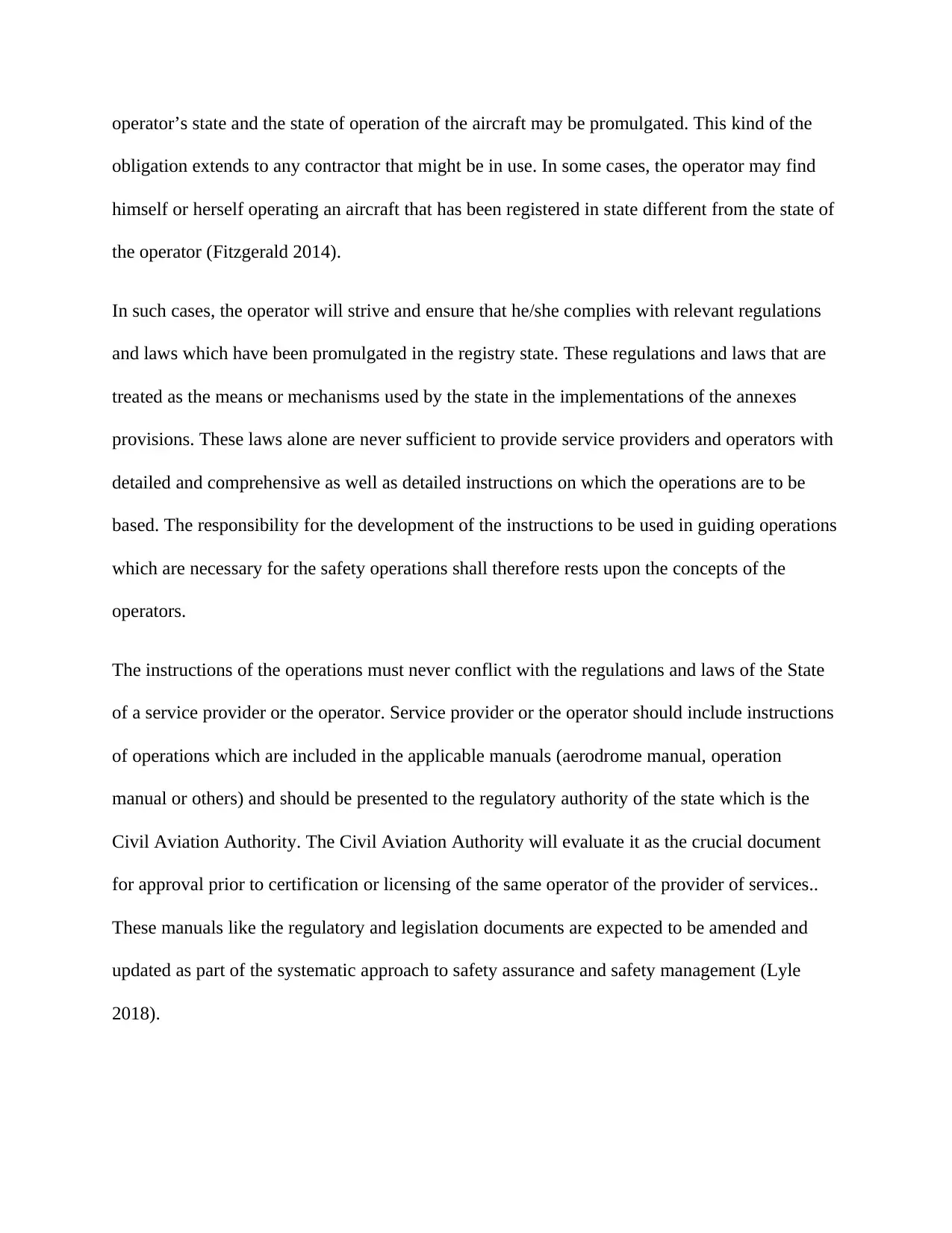
operator’s state and the state of operation of the aircraft may be promulgated. This kind of the
obligation extends to any contractor that might be in use. In some cases, the operator may find
himself or herself operating an aircraft that has been registered in state different from the state of
the operator (Fitzgerald 2014).
In such cases, the operator will strive and ensure that he/she complies with relevant regulations
and laws which have been promulgated in the registry state. These regulations and laws that are
treated as the means or mechanisms used by the state in the implementations of the annexes
provisions. These laws alone are never sufficient to provide service providers and operators with
detailed and comprehensive as well as detailed instructions on which the operations are to be
based. The responsibility for the development of the instructions to be used in guiding operations
which are necessary for the safety operations shall therefore rests upon the concepts of the
operators.
The instructions of the operations must never conflict with the regulations and laws of the State
of a service provider or the operator. Service provider or the operator should include instructions
of operations which are included in the applicable manuals (aerodrome manual, operation
manual or others) and should be presented to the regulatory authority of the state which is the
Civil Aviation Authority. The Civil Aviation Authority will evaluate it as the crucial document
for approval prior to certification or licensing of the same operator of the provider of services..
These manuals like the regulatory and legislation documents are expected to be amended and
updated as part of the systematic approach to safety assurance and safety management (Lyle
2018).
obligation extends to any contractor that might be in use. In some cases, the operator may find
himself or herself operating an aircraft that has been registered in state different from the state of
the operator (Fitzgerald 2014).
In such cases, the operator will strive and ensure that he/she complies with relevant regulations
and laws which have been promulgated in the registry state. These regulations and laws that are
treated as the means or mechanisms used by the state in the implementations of the annexes
provisions. These laws alone are never sufficient to provide service providers and operators with
detailed and comprehensive as well as detailed instructions on which the operations are to be
based. The responsibility for the development of the instructions to be used in guiding operations
which are necessary for the safety operations shall therefore rests upon the concepts of the
operators.
The instructions of the operations must never conflict with the regulations and laws of the State
of a service provider or the operator. Service provider or the operator should include instructions
of operations which are included in the applicable manuals (aerodrome manual, operation
manual or others) and should be presented to the regulatory authority of the state which is the
Civil Aviation Authority. The Civil Aviation Authority will evaluate it as the crucial document
for approval prior to certification or licensing of the same operator of the provider of services..
These manuals like the regulatory and legislation documents are expected to be amended and
updated as part of the systematic approach to safety assurance and safety management (Lyle
2018).
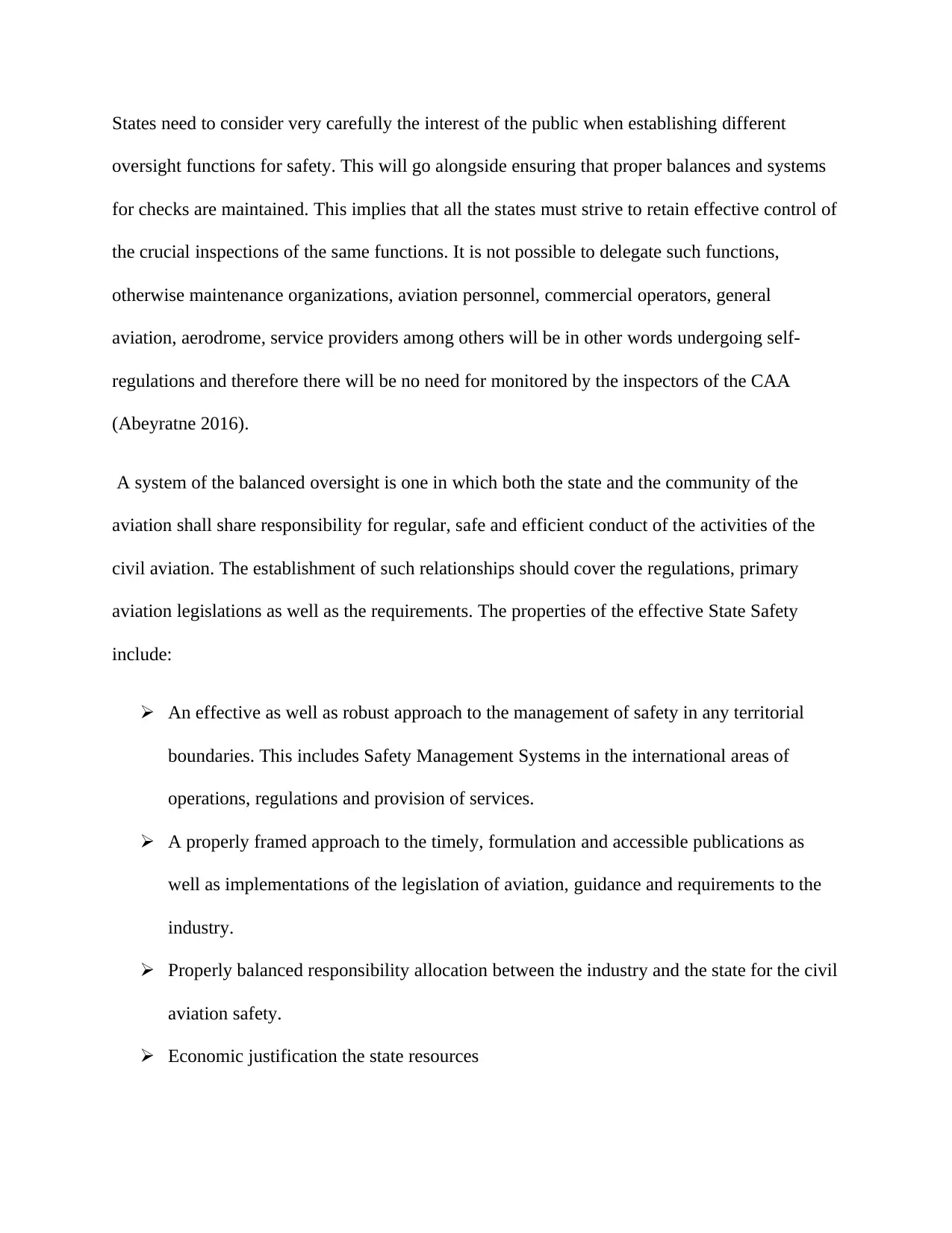
States need to consider very carefully the interest of the public when establishing different
oversight functions for safety. This will go alongside ensuring that proper balances and systems
for checks are maintained. This implies that all the states must strive to retain effective control of
the crucial inspections of the same functions. It is not possible to delegate such functions,
otherwise maintenance organizations, aviation personnel, commercial operators, general
aviation, aerodrome, service providers among others will be in other words undergoing self-
regulations and therefore there will be no need for monitored by the inspectors of the CAA
(Abeyratne 2016).
A system of the balanced oversight is one in which both the state and the community of the
aviation shall share responsibility for regular, safe and efficient conduct of the activities of the
civil aviation. The establishment of such relationships should cover the regulations, primary
aviation legislations as well as the requirements. The properties of the effective State Safety
include:
An effective as well as robust approach to the management of safety in any territorial
boundaries. This includes Safety Management Systems in the international areas of
operations, regulations and provision of services.
A properly framed approach to the timely, formulation and accessible publications as
well as implementations of the legislation of aviation, guidance and requirements to the
industry.
Properly balanced responsibility allocation between the industry and the state for the civil
aviation safety.
Economic justification the state resources
oversight functions for safety. This will go alongside ensuring that proper balances and systems
for checks are maintained. This implies that all the states must strive to retain effective control of
the crucial inspections of the same functions. It is not possible to delegate such functions,
otherwise maintenance organizations, aviation personnel, commercial operators, general
aviation, aerodrome, service providers among others will be in other words undergoing self-
regulations and therefore there will be no need for monitored by the inspectors of the CAA
(Abeyratne 2016).
A system of the balanced oversight is one in which both the state and the community of the
aviation shall share responsibility for regular, safe and efficient conduct of the activities of the
civil aviation. The establishment of such relationships should cover the regulations, primary
aviation legislations as well as the requirements. The properties of the effective State Safety
include:
An effective as well as robust approach to the management of safety in any territorial
boundaries. This includes Safety Management Systems in the international areas of
operations, regulations and provision of services.
A properly framed approach to the timely, formulation and accessible publications as
well as implementations of the legislation of aviation, guidance and requirements to the
industry.
Properly balanced responsibility allocation between the industry and the state for the civil
aviation safety.
Economic justification the state resources
Secure Best Marks with AI Grader
Need help grading? Try our AI Grader for instant feedback on your assignments.
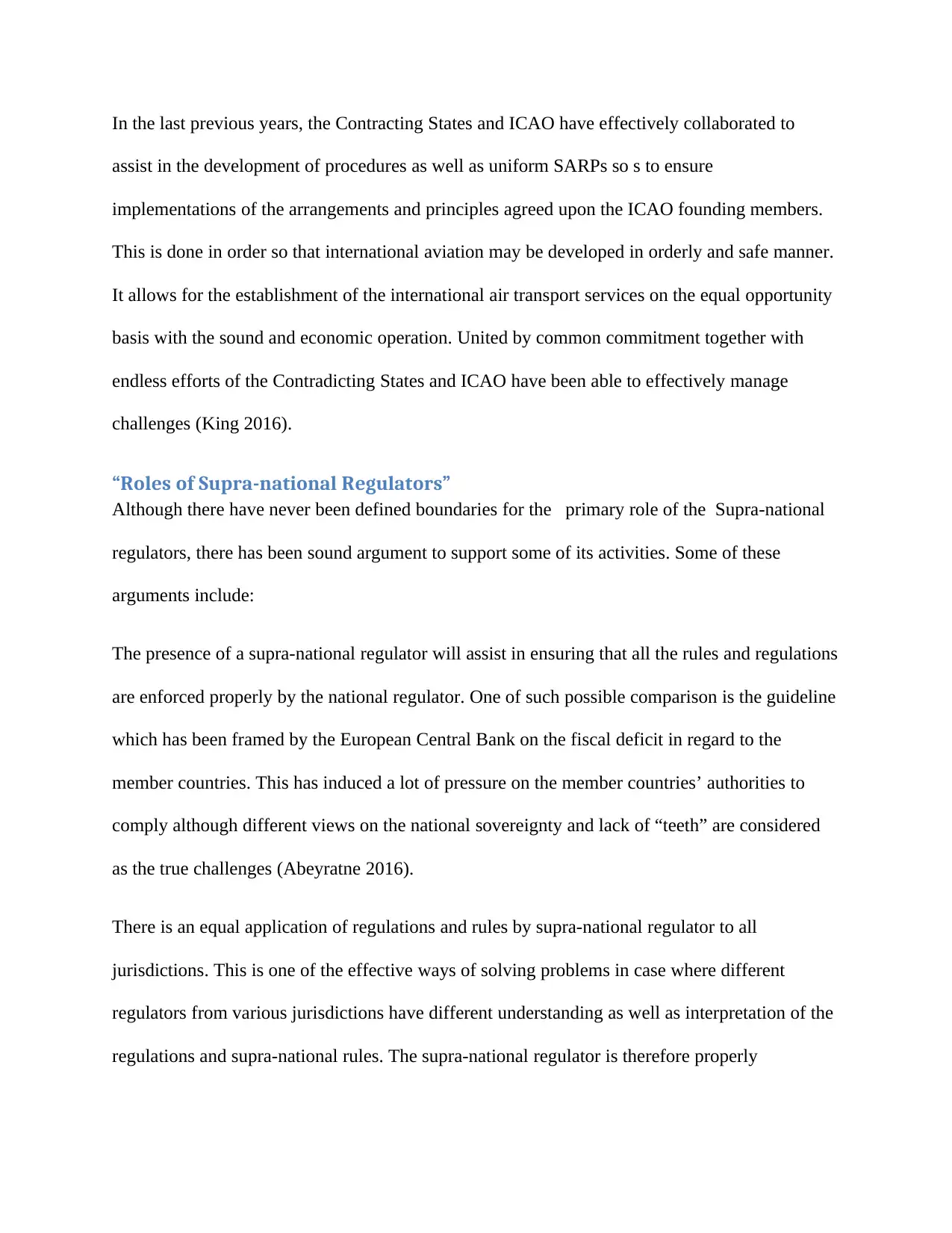
In the last previous years, the Contracting States and ICAO have effectively collaborated to
assist in the development of procedures as well as uniform SARPs so s to ensure
implementations of the arrangements and principles agreed upon the ICAO founding members.
This is done in order so that international aviation may be developed in orderly and safe manner.
It allows for the establishment of the international air transport services on the equal opportunity
basis with the sound and economic operation. United by common commitment together with
endless efforts of the Contradicting States and ICAO have been able to effectively manage
challenges (King 2016).
“Roles of Supra-national Regulators”
Although there have never been defined boundaries for the primary role of the Supra-national
regulators, there has been sound argument to support some of its activities. Some of these
arguments include:
The presence of a supra-national regulator will assist in ensuring that all the rules and regulations
are enforced properly by the national regulator. One of such possible comparison is the guideline
which has been framed by the European Central Bank on the fiscal deficit in regard to the
member countries. This has induced a lot of pressure on the member countries’ authorities to
comply although different views on the national sovereignty and lack of “teeth” are considered
as the true challenges (Abeyratne 2016).
There is an equal application of regulations and rules by supra-national regulator to all
jurisdictions. This is one of the effective ways of solving problems in case where different
regulators from various jurisdictions have different understanding as well as interpretation of the
regulations and supra-national rules. The supra-national regulator is therefore properly
assist in the development of procedures as well as uniform SARPs so s to ensure
implementations of the arrangements and principles agreed upon the ICAO founding members.
This is done in order so that international aviation may be developed in orderly and safe manner.
It allows for the establishment of the international air transport services on the equal opportunity
basis with the sound and economic operation. United by common commitment together with
endless efforts of the Contradicting States and ICAO have been able to effectively manage
challenges (King 2016).
“Roles of Supra-national Regulators”
Although there have never been defined boundaries for the primary role of the Supra-national
regulators, there has been sound argument to support some of its activities. Some of these
arguments include:
The presence of a supra-national regulator will assist in ensuring that all the rules and regulations
are enforced properly by the national regulator. One of such possible comparison is the guideline
which has been framed by the European Central Bank on the fiscal deficit in regard to the
member countries. This has induced a lot of pressure on the member countries’ authorities to
comply although different views on the national sovereignty and lack of “teeth” are considered
as the true challenges (Abeyratne 2016).
There is an equal application of regulations and rules by supra-national regulator to all
jurisdictions. This is one of the effective ways of solving problems in case where different
regulators from various jurisdictions have different understanding as well as interpretation of the
regulations and supra-national rules. The supra-national regulator is therefore properly
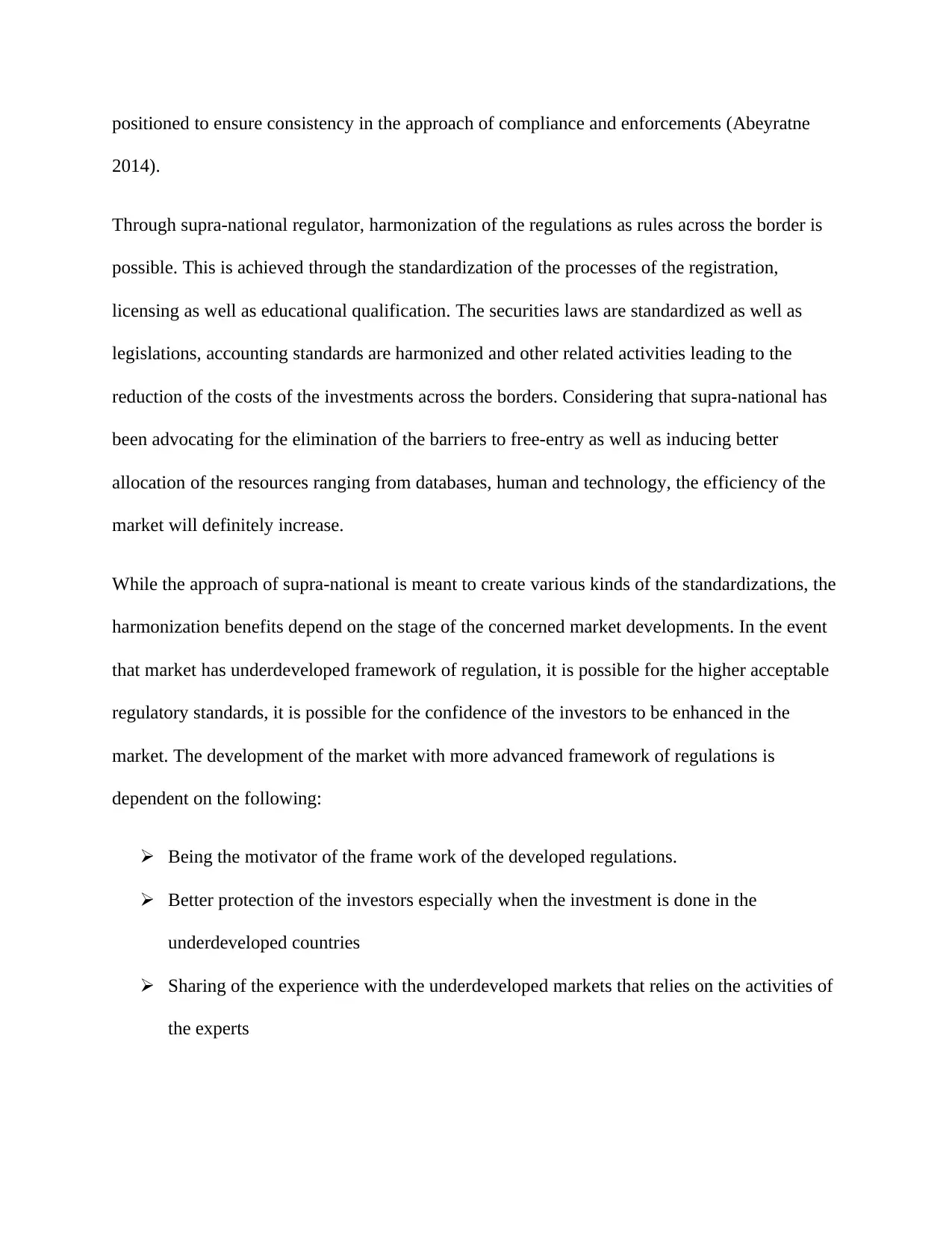
positioned to ensure consistency in the approach of compliance and enforcements (Abeyratne
2014).
Through supra-national regulator, harmonization of the regulations as rules across the border is
possible. This is achieved through the standardization of the processes of the registration,
licensing as well as educational qualification. The securities laws are standardized as well as
legislations, accounting standards are harmonized and other related activities leading to the
reduction of the costs of the investments across the borders. Considering that supra-national has
been advocating for the elimination of the barriers to free-entry as well as inducing better
allocation of the resources ranging from databases, human and technology, the efficiency of the
market will definitely increase.
While the approach of supra-national is meant to create various kinds of the standardizations, the
harmonization benefits depend on the stage of the concerned market developments. In the event
that market has underdeveloped framework of regulation, it is possible for the higher acceptable
regulatory standards, it is possible for the confidence of the investors to be enhanced in the
market. The development of the market with more advanced framework of regulations is
dependent on the following:
Being the motivator of the frame work of the developed regulations.
Better protection of the investors especially when the investment is done in the
underdeveloped countries
Sharing of the experience with the underdeveloped markets that relies on the activities of
the experts
2014).
Through supra-national regulator, harmonization of the regulations as rules across the border is
possible. This is achieved through the standardization of the processes of the registration,
licensing as well as educational qualification. The securities laws are standardized as well as
legislations, accounting standards are harmonized and other related activities leading to the
reduction of the costs of the investments across the borders. Considering that supra-national has
been advocating for the elimination of the barriers to free-entry as well as inducing better
allocation of the resources ranging from databases, human and technology, the efficiency of the
market will definitely increase.
While the approach of supra-national is meant to create various kinds of the standardizations, the
harmonization benefits depend on the stage of the concerned market developments. In the event
that market has underdeveloped framework of regulation, it is possible for the higher acceptable
regulatory standards, it is possible for the confidence of the investors to be enhanced in the
market. The development of the market with more advanced framework of regulations is
dependent on the following:
Being the motivator of the frame work of the developed regulations.
Better protection of the investors especially when the investment is done in the
underdeveloped countries
Sharing of the experience with the underdeveloped markets that relies on the activities of
the experts
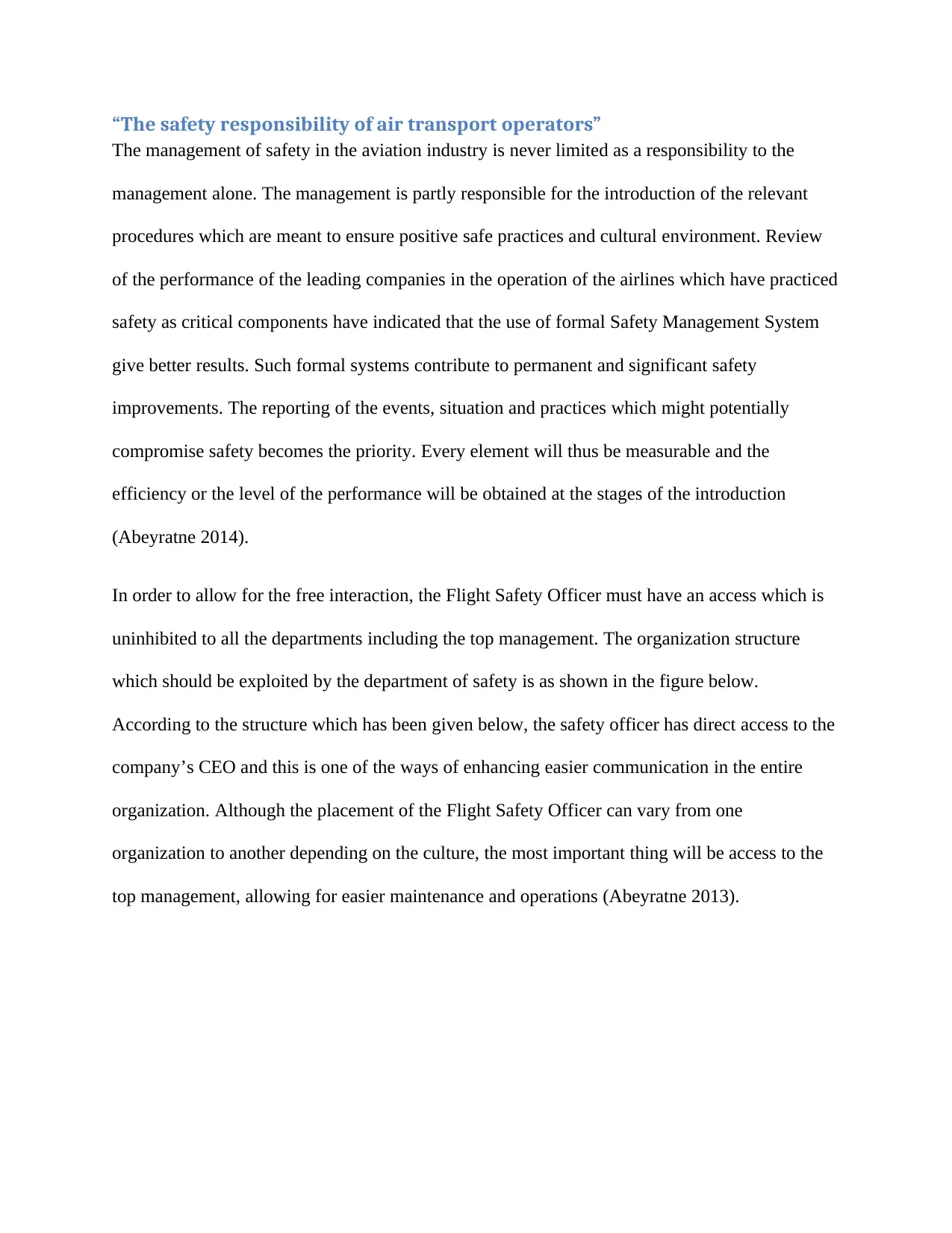
“The safety responsibility of air transport operators”
The management of safety in the aviation industry is never limited as a responsibility to the
management alone. The management is partly responsible for the introduction of the relevant
procedures which are meant to ensure positive safe practices and cultural environment. Review
of the performance of the leading companies in the operation of the airlines which have practiced
safety as critical components have indicated that the use of formal Safety Management System
give better results. Such formal systems contribute to permanent and significant safety
improvements. The reporting of the events, situation and practices which might potentially
compromise safety becomes the priority. Every element will thus be measurable and the
efficiency or the level of the performance will be obtained at the stages of the introduction
(Abeyratne 2014).
In order to allow for the free interaction, the Flight Safety Officer must have an access which is
uninhibited to all the departments including the top management. The organization structure
which should be exploited by the department of safety is as shown in the figure below.
According to the structure which has been given below, the safety officer has direct access to the
company’s CEO and this is one of the ways of enhancing easier communication in the entire
organization. Although the placement of the Flight Safety Officer can vary from one
organization to another depending on the culture, the most important thing will be access to the
top management, allowing for easier maintenance and operations (Abeyratne 2013).
The management of safety in the aviation industry is never limited as a responsibility to the
management alone. The management is partly responsible for the introduction of the relevant
procedures which are meant to ensure positive safe practices and cultural environment. Review
of the performance of the leading companies in the operation of the airlines which have practiced
safety as critical components have indicated that the use of formal Safety Management System
give better results. Such formal systems contribute to permanent and significant safety
improvements. The reporting of the events, situation and practices which might potentially
compromise safety becomes the priority. Every element will thus be measurable and the
efficiency or the level of the performance will be obtained at the stages of the introduction
(Abeyratne 2014).
In order to allow for the free interaction, the Flight Safety Officer must have an access which is
uninhibited to all the departments including the top management. The organization structure
which should be exploited by the department of safety is as shown in the figure below.
According to the structure which has been given below, the safety officer has direct access to the
company’s CEO and this is one of the ways of enhancing easier communication in the entire
organization. Although the placement of the Flight Safety Officer can vary from one
organization to another depending on the culture, the most important thing will be access to the
top management, allowing for easier maintenance and operations (Abeyratne 2013).
Paraphrase This Document
Need a fresh take? Get an instant paraphrase of this document with our AI Paraphraser
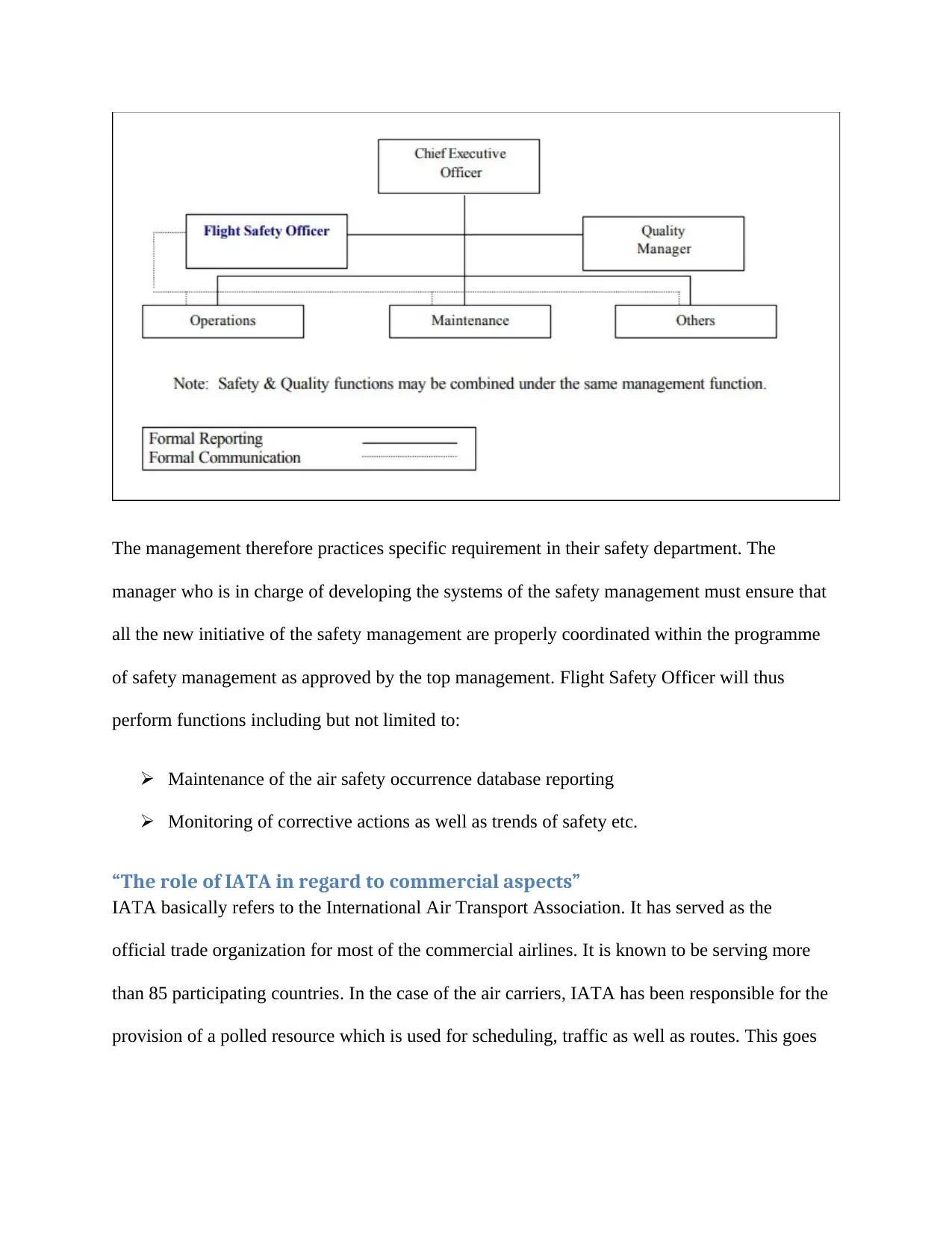
The management therefore practices specific requirement in their safety department. The
manager who is in charge of developing the systems of the safety management must ensure that
all the new initiative of the safety management are properly coordinated within the programme
of safety management as approved by the top management. Flight Safety Officer will thus
perform functions including but not limited to:
Maintenance of the air safety occurrence database reporting
Monitoring of corrective actions as well as trends of safety etc.
“The role of IATA in regard to commercial aspects”
IATA basically refers to the International Air Transport Association. It has served as the
official trade organization for most of the commercial airlines. It is known to be serving more
than 85 participating countries. In the case of the air carriers, IATA has been responsible for the
provision of a polled resource which is used for scheduling, traffic as well as routes. This goes
manager who is in charge of developing the systems of the safety management must ensure that
all the new initiative of the safety management are properly coordinated within the programme
of safety management as approved by the top management. Flight Safety Officer will thus
perform functions including but not limited to:
Maintenance of the air safety occurrence database reporting
Monitoring of corrective actions as well as trends of safety etc.
“The role of IATA in regard to commercial aspects”
IATA basically refers to the International Air Transport Association. It has served as the
official trade organization for most of the commercial airlines. It is known to be serving more
than 85 participating countries. In the case of the air carriers, IATA has been responsible for the
provision of a polled resource which is used for scheduling, traffic as well as routes. This goes
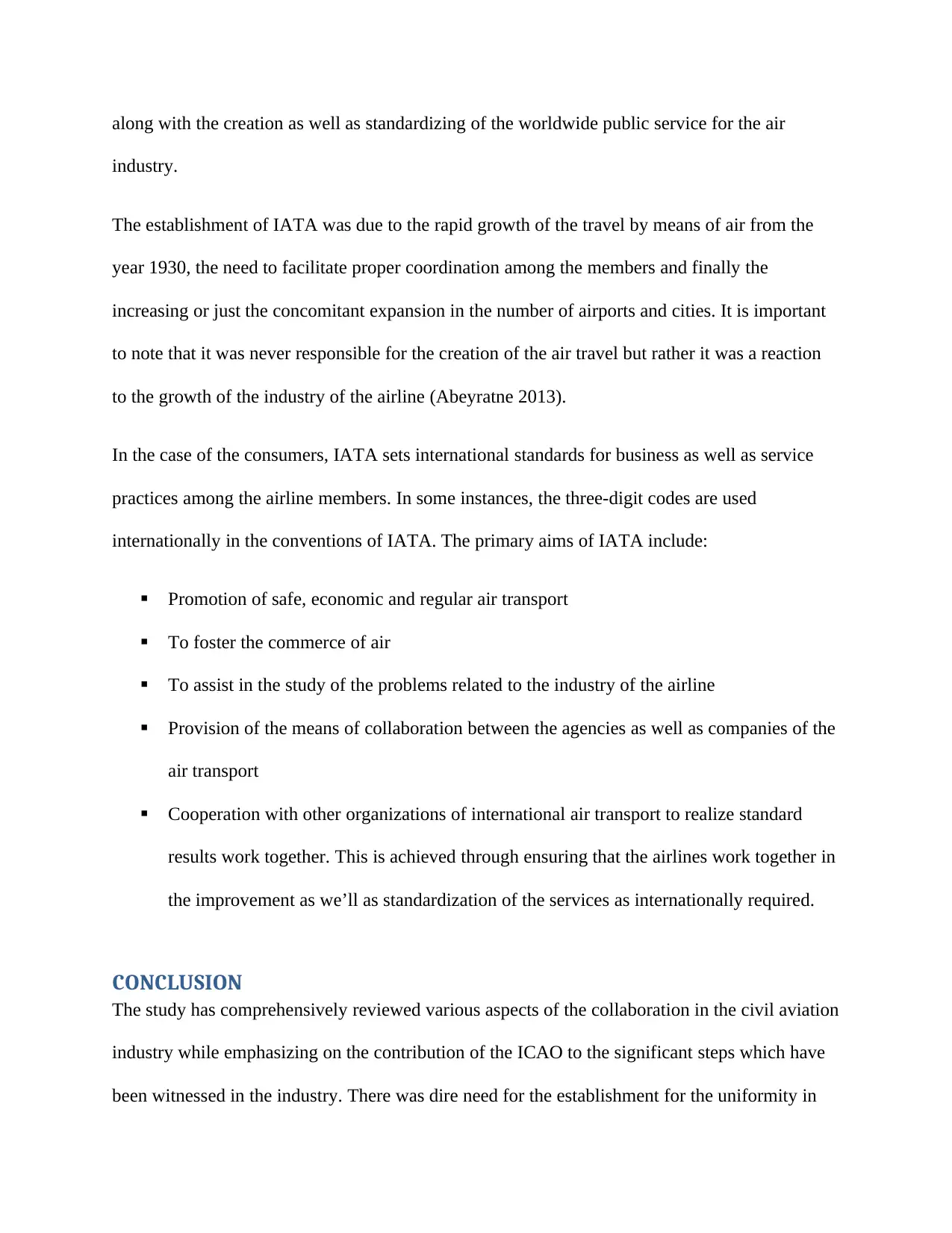
along with the creation as well as standardizing of the worldwide public service for the air
industry.
The establishment of IATA was due to the rapid growth of the travel by means of air from the
year 1930, the need to facilitate proper coordination among the members and finally the
increasing or just the concomitant expansion in the number of airports and cities. It is important
to note that it was never responsible for the creation of the air travel but rather it was a reaction
to the growth of the industry of the airline (Abeyratne 2013).
In the case of the consumers, IATA sets international standards for business as well as service
practices among the airline members. In some instances, the three-digit codes are used
internationally in the conventions of IATA. The primary aims of IATA include:
Promotion of safe, economic and regular air transport
To foster the commerce of air
To assist in the study of the problems related to the industry of the airline
Provision of the means of collaboration between the agencies as well as companies of the
air transport
Cooperation with other organizations of international air transport to realize standard
results work together. This is achieved through ensuring that the airlines work together in
the improvement as we’ll as standardization of the services as internationally required.
CONCLUSION
The study has comprehensively reviewed various aspects of the collaboration in the civil aviation
industry while emphasizing on the contribution of the ICAO to the significant steps which have
been witnessed in the industry. There was dire need for the establishment for the uniformity in
industry.
The establishment of IATA was due to the rapid growth of the travel by means of air from the
year 1930, the need to facilitate proper coordination among the members and finally the
increasing or just the concomitant expansion in the number of airports and cities. It is important
to note that it was never responsible for the creation of the air travel but rather it was a reaction
to the growth of the industry of the airline (Abeyratne 2013).
In the case of the consumers, IATA sets international standards for business as well as service
practices among the airline members. In some instances, the three-digit codes are used
internationally in the conventions of IATA. The primary aims of IATA include:
Promotion of safe, economic and regular air transport
To foster the commerce of air
To assist in the study of the problems related to the industry of the airline
Provision of the means of collaboration between the agencies as well as companies of the
air transport
Cooperation with other organizations of international air transport to realize standard
results work together. This is achieved through ensuring that the airlines work together in
the improvement as we’ll as standardization of the services as internationally required.
CONCLUSION
The study has comprehensively reviewed various aspects of the collaboration in the civil aviation
industry while emphasizing on the contribution of the ICAO to the significant steps which have
been witnessed in the industry. There was dire need for the establishment for the uniformity in
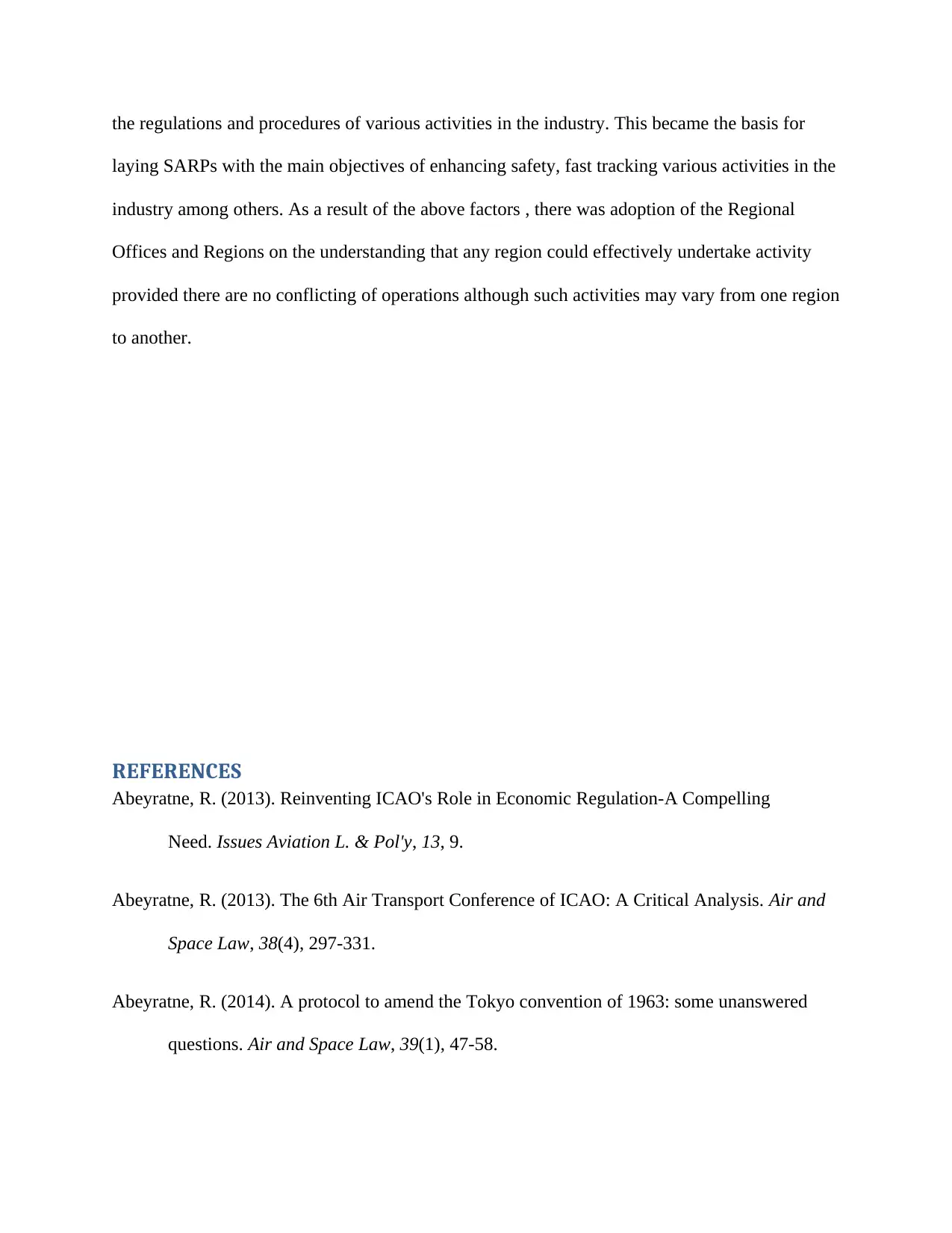
the regulations and procedures of various activities in the industry. This became the basis for
laying SARPs with the main objectives of enhancing safety, fast tracking various activities in the
industry among others. As a result of the above factors , there was adoption of the Regional
Offices and Regions on the understanding that any region could effectively undertake activity
provided there are no conflicting of operations although such activities may vary from one region
to another.
REFERENCES
Abeyratne, R. (2013). Reinventing ICAO's Role in Economic Regulation-A Compelling
Need. Issues Aviation L. & Pol'y, 13, 9.
Abeyratne, R. (2013). The 6th Air Transport Conference of ICAO: A Critical Analysis. Air and
Space Law, 38(4), 297-331.
Abeyratne, R. (2014). A protocol to amend the Tokyo convention of 1963: some unanswered
questions. Air and Space Law, 39(1), 47-58.
laying SARPs with the main objectives of enhancing safety, fast tracking various activities in the
industry among others. As a result of the above factors , there was adoption of the Regional
Offices and Regions on the understanding that any region could effectively undertake activity
provided there are no conflicting of operations although such activities may vary from one region
to another.
REFERENCES
Abeyratne, R. (2013). Reinventing ICAO's Role in Economic Regulation-A Compelling
Need. Issues Aviation L. & Pol'y, 13, 9.
Abeyratne, R. (2013). The 6th Air Transport Conference of ICAO: A Critical Analysis. Air and
Space Law, 38(4), 297-331.
Abeyratne, R. (2014). A protocol to amend the Tokyo convention of 1963: some unanswered
questions. Air and Space Law, 39(1), 47-58.
Secure Best Marks with AI Grader
Need help grading? Try our AI Grader for instant feedback on your assignments.
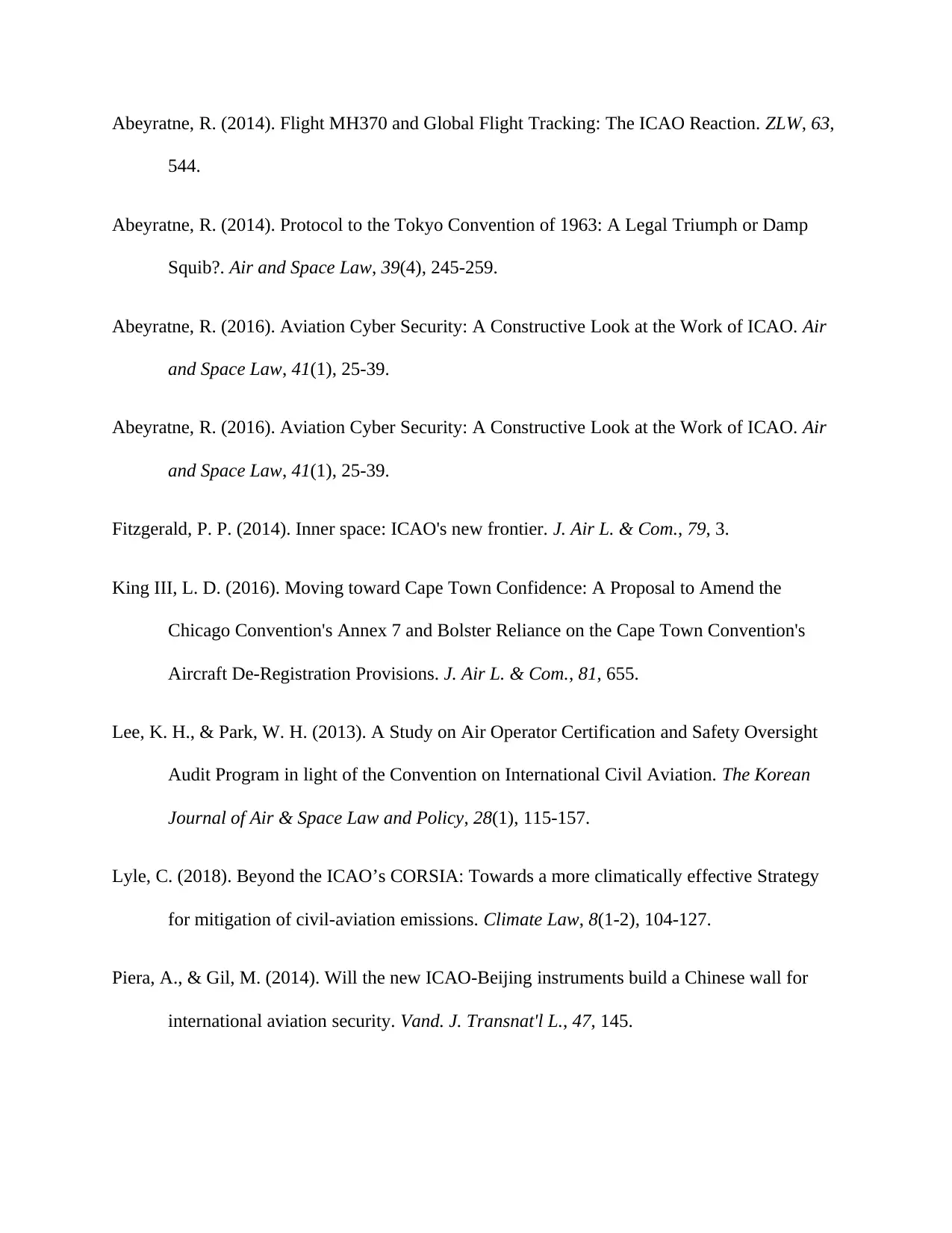
Abeyratne, R. (2014). Flight MH370 and Global Flight Tracking: The ICAO Reaction. ZLW, 63,
544.
Abeyratne, R. (2014). Protocol to the Tokyo Convention of 1963: A Legal Triumph or Damp
Squib?. Air and Space Law, 39(4), 245-259.
Abeyratne, R. (2016). Aviation Cyber Security: A Constructive Look at the Work of ICAO. Air
and Space Law, 41(1), 25-39.
Abeyratne, R. (2016). Aviation Cyber Security: A Constructive Look at the Work of ICAO. Air
and Space Law, 41(1), 25-39.
Fitzgerald, P. P. (2014). Inner space: ICAO's new frontier. J. Air L. & Com., 79, 3.
King III, L. D. (2016). Moving toward Cape Town Confidence: A Proposal to Amend the
Chicago Convention's Annex 7 and Bolster Reliance on the Cape Town Convention's
Aircraft De-Registration Provisions. J. Air L. & Com., 81, 655.
Lee, K. H., & Park, W. H. (2013). A Study on Air Operator Certification and Safety Oversight
Audit Program in light of the Convention on International Civil Aviation. The Korean
Journal of Air & Space Law and Policy, 28(1), 115-157.
Lyle, C. (2018). Beyond the ICAO’s CORSIA: Towards a more climatically effective Strategy
for mitigation of civil-aviation emissions. Climate Law, 8(1-2), 104-127.
Piera, A., & Gil, M. (2014). Will the new ICAO-Beijing instruments build a Chinese wall for
international aviation security. Vand. J. Transnat'l L., 47, 145.
544.
Abeyratne, R. (2014). Protocol to the Tokyo Convention of 1963: A Legal Triumph or Damp
Squib?. Air and Space Law, 39(4), 245-259.
Abeyratne, R. (2016). Aviation Cyber Security: A Constructive Look at the Work of ICAO. Air
and Space Law, 41(1), 25-39.
Abeyratne, R. (2016). Aviation Cyber Security: A Constructive Look at the Work of ICAO. Air
and Space Law, 41(1), 25-39.
Fitzgerald, P. P. (2014). Inner space: ICAO's new frontier. J. Air L. & Com., 79, 3.
King III, L. D. (2016). Moving toward Cape Town Confidence: A Proposal to Amend the
Chicago Convention's Annex 7 and Bolster Reliance on the Cape Town Convention's
Aircraft De-Registration Provisions. J. Air L. & Com., 81, 655.
Lee, K. H., & Park, W. H. (2013). A Study on Air Operator Certification and Safety Oversight
Audit Program in light of the Convention on International Civil Aviation. The Korean
Journal of Air & Space Law and Policy, 28(1), 115-157.
Lyle, C. (2018). Beyond the ICAO’s CORSIA: Towards a more climatically effective Strategy
for mitigation of civil-aviation emissions. Climate Law, 8(1-2), 104-127.
Piera, A., & Gil, M. (2014). Will the new ICAO-Beijing instruments build a Chinese wall for
international aviation security. Vand. J. Transnat'l L., 47, 145.
1 out of 17
Related Documents
Your All-in-One AI-Powered Toolkit for Academic Success.
+13062052269
info@desklib.com
Available 24*7 on WhatsApp / Email
![[object Object]](/_next/static/media/star-bottom.7253800d.svg)
Unlock your academic potential
© 2024 | Zucol Services PVT LTD | All rights reserved.





